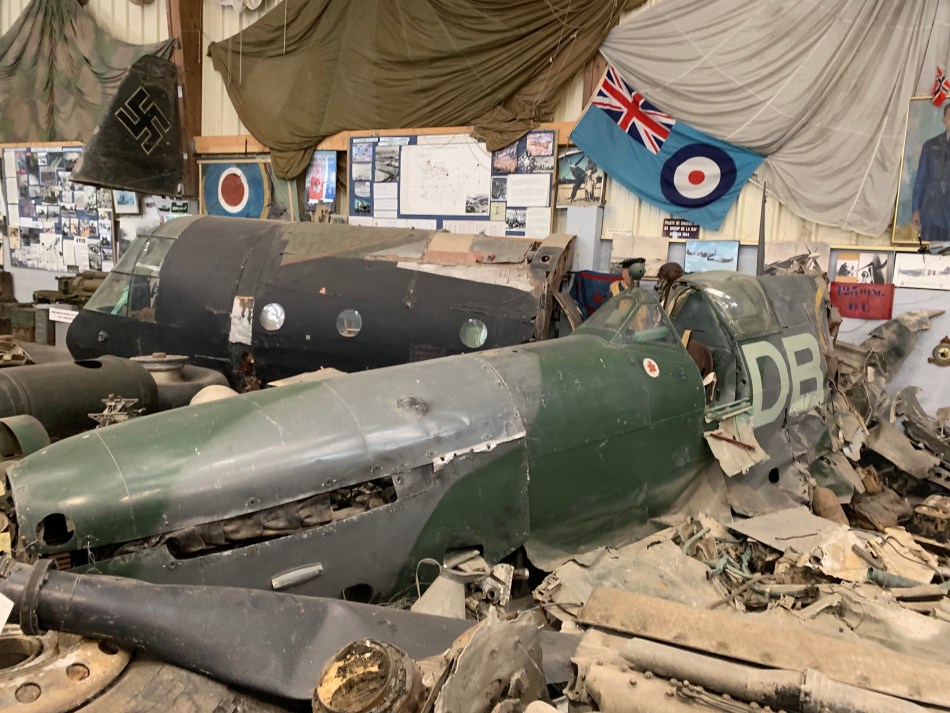It was a two hour drive from Rouen to the area where my father, Geoffrey Donald Corry, fought in World War Two. He landed on Juno Beach on June 6, 1944 in the second wave. He was a 21 year-old lieutenant leading a platoon of soldiers of “C” Company in the Canadian Scottish Regiment, and he saw 30 days of action before being injured. I keep his helmet in full view in my home as a reminder of not only his service and sacrifice, but also of the very fine line between life and death – his helmet has three bullet holes in it. He was called “Lucky Corry” for good reason!

First stop was at Putot-en-Bessin, one of several locations where my father saw action. The location was typical of the topography the Canadian soldiers faced as they covered open fields and faced walled villages, church towers (with snipers) and hedgerows.

I paid my respects to those who had fallen there, many of whom my father knew.

Next stop was Courseulles-sur-Mer, which is where the Canadian Juno Beach Museum is, and where my father landed 75 years earlier. This was a side-trip for my Chaucer research, as I’d never been able to join my father on his two previous trips (in 1994, on the 50th anniversary of D-Day, and a few years later, when he came with my sister).
Stopped on a street a few blocks from the beach to get a baguette sandwich and a coke. The woman behind the counter was no more than 16, and she spoke very little English, but she understood hunger well enough.

The town was filled with reminders of the battle that defined a generation, and enduring respect and recognition for the Canadians who helped liberate a country.

It was too early to check in to the hotel, so went to the museum. The 75thanniversary of D-Day celebrations were held here earlier in June, with the Prime Minister attending, and the Canadian attendants who worked at the museum were still giddy about the visit.

Was given a brief overview of the museum, and then joined an excellent tour of the German bunkers. Fascinating to see how bunkers designed in 1940 were not defensive in any way, whereas those in 1944 were all about defence.



Returning to the museum I took in the exhibits and finished with the short but moving film that captured the sense of the soldiers who landed here. I left with tears running down my face, returning to the hotel to check-in.
The room faced the ocean, with just a boardwalk separating building and ocean, and the wind whistled through a tiny crack in the window. A group of teenaged girls in wetsuits were finishing a windsurfing class. I imagined the wide open beach jammed with concrete obstacles (all mined) to stop tanks and landing craft, and the beach filled with barbed wire. The German machine gunners had a 180 degree view of the beach, which at low tide extended for hundreds of metres.

Thankfully my father landed on the second wave of D-Day, so missed the initial battle, but several battles lay ahead.
Later that afternoon went to visit Dr. Jean-Pierre Benamou, a medical doctor, military historian and author of several books on the Battle of Normandy. When my father and mother came to visit my sister in Paris they all drove to Normandy together, and visited the same places with Jean-Pierre. It was a 50 year reunion for dad with his experiences in Normandy and all quite an eye opener for my sister and mom. He then met my mother and father again in Victoria in 1995. He had agreed to meet me at his unique “D-Day Academy” nearby in Rots, where he provides tours in period vehicles of D-Day locations and gives talks on the facts of the various battles that occurred during the campaign. And a lot more…






I was awestruck looking at the very real equipment, armaments, vehicles and planes – both Allied and German – that I had fantasized about as a boy, playing with plastic soldiers. I stumbled upon a mannequin of a Canadian Scottish soldier dressed in his kit – exactly as my father would have worn. Eerie!

Then Jean-Pierre took us on a tour to Rots, and the plaque commemorating those lives lost in the fighting nearby – men whom my father would have known. I found it very moving.

Then Jean-Pierre led us to the village of Cussy. it was here, on July 7, 1944, 30 days after my father landed, that he was shot in the helmet by a sniper from the village as his company advanced across open fields towards what they thought was an empty village.


The shot knocked my dad’s helmet off and he picked it up, swearing at the sniper, who was soon knocked out.

The company advanced at a run, with bullets whizzing by, and before he knew it, Geoff was hit in the knee, and fell by a low wall. He peered up an “ping”, another shot hit his helmet. He was staring at Germans and a Panzer tank, and thought he was a goner. Luckily he was saved by reinforcements who continued to attack the village. Dad was evacuated (but not before more close calls) to England and that was the end of his war. You can read his memoirs of his action in Normandy here.
The Canadian Scottish had never been credited for this attack, as historical records had another regiment clearing the town. Jean-Pierre’s publishing of this account helped ensure the Scottish were included, and the historical facts corrected. The village street names reference this key part of the town’s history…

Jean-Pierre’s recounting of the action, affirming my father’s account in his memoirs, reaffirmed the sense of the fine line between life and death, in this case, a matter of inches.
